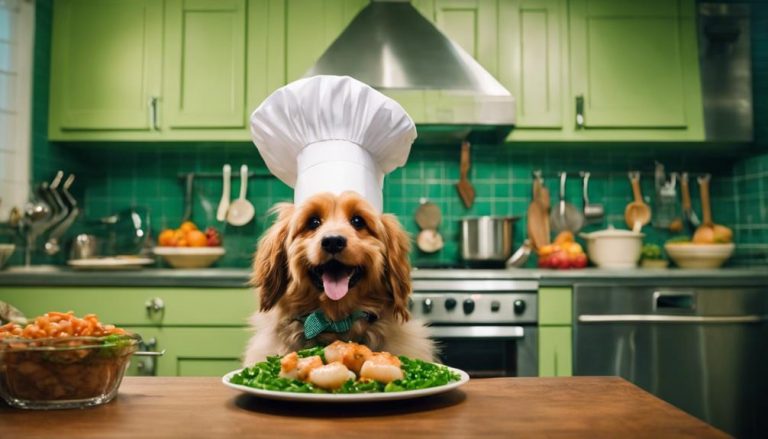Scallops: Safe Canine Treats?
Dogs can enjoy scallops as a treat when they’re cooked properly and given in small amounts. Cooking them thoroughly is crucial to kill off harmful bacteria, and it’s best to serve them plain, without any seasonings or oils that could harm your dog. Avoid giving your dog raw scallops; they can carry toxins, especially in the orange part, and might be contaminated with pollutants. It’s also important to consider where the scallops come from to ensure they’re safe and of good quality.
Scallops are a good source of protein and omega-3 fatty acids, which can help with muscle maintenance and promote a shiny coat and healthy skin. However, before adding scallops to your dog’s diet, it’s wise to talk to a vet. This will help you avoid any negative reactions and determine the right serving size. Cooking scallops simply by steaming or boiling them is the safest way to prepare them for your dog.
Key Takeaways
- Cooked scallops are safe for dogs, avoid seasonings.
- Raw scallops pose a health risk; cooking is mandatory.
- Scallops benefit a dog’s muscles and coat, consult a vet.
Understanding Scallop Safety
If you’re thinking about adding scallops to your dog’s meals, it’s crucial to be aware of the safety concerns. Raw scallops can be risky because they might contain dangerous toxins and pollutants, particularly in the orange part. This could harm your dog’s health. The source and quality of the scallops matter a lot. Dogs living in places with a lot of pollution should steer clear of raw scallops due to the higher chance of health issues.
Cooking scallops is a much safer bet as it can kill off these harmful substances. Before you start serving cooked scallops to your pup, it’s a smart move to talk to your vet. They can tell you if it’s a good fit for your dog’s diet and health.
Nutritional Benefits for Dogs
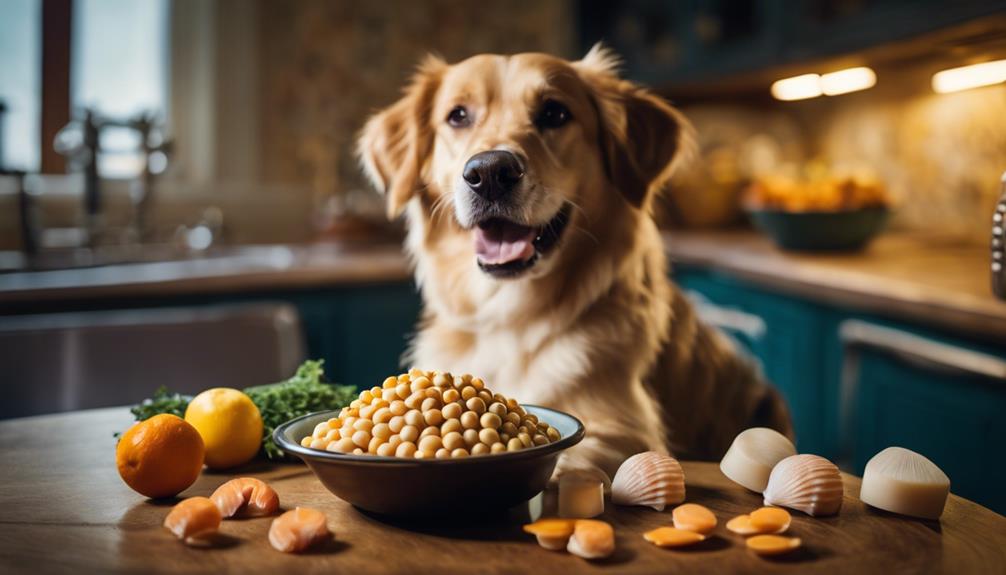
Looking at the nutritional benefits of scallops for dogs, we find they’re a great source of protein and omega-3 fatty acids. These nutrients are essential for building strong muscles and ensuring a shiny, healthy coat. When prepared correctly and fed in moderation, scallops can be a healthy addition to your dog’s diet.
Scallops offer key nutrients that support your dog’s overall well-being. Proper preparation and portion control are crucial to safely include them in your pet’s meals. This approach can enhance your dog’s health, contributing to their muscle strength and the condition of their skin and coat.
Protein Source
Scallops, known for their rich protein content, are great for dogs to help with muscle health. However, it’s important to be cautious, especially with raw scallops. Here are some tips to consider:
Scallops are a lean protein source, perfect for keeping your dog’s muscles strong and healthy. But, it’s essential to cook them properly to avoid any health risks associated with raw seafood.
When adding scallops to your dog’s diet, do so sparingly to maintain a balanced diet. Also, when preparing scallops for your dog, it’s best to skip any seasonings or oils that might not be good for them.
Omega-3 Fatty Acids
Omega-3 fatty acids, plentiful in scallops, are key to enhancing your dog’s health, notably in areas like skin condition and joint flexibility. Including scallops in your dog’s meals is a smart move due to these benefits. Omega-3s help soothe skin irritation and inflammation, leading to a healthier, more lustrous coat and aiding in allergy management.
These nutrients also support brain health, cognitive growth, and strengthen the immune system. Scallops, being a rich source of omega-3s, help alleviate joint stiffness, making them a great addition for dogs needing mobility support. Feeding your dog scallops as a part of a well-rounded diet introduces them to crucial fatty acids essential for their health.
Preparing Scallops for Dogs

When cooking scallops for dogs, it’s key to ensure they are fully cooked to eliminate any bacteria. This means serving the scallops plain, without any added seasonings or sauces that could harm your dog.
It’s also essential to figure out the right portion size for your dog to avoid any stomach upset. Talking to a vet can help you get this right, emphasizing the need for moderation.
Cooking Methods Matter
When you’re cooking scallops for your dog, choosing the right method is critical for their well-being and ease of digestion. The cooking technique significantly influences whether scallops are a good choice for your dog. Here’s what you need to know:
Boiling or steaming scallops is a great way to make them softer and easier for your dog to digest. This method doesn’t add any unhealthy fats, which is a plus for your dog’s health. Grilling or baking scallops without any added seasonings is also a safe option, keeping your pet from potential stomach issues.
It’s important to prepare scallops without oils or butter since too much fat isn’t good for dogs. Also, cutting the scallops into small pieces can prevent choking hazards, making them a safer choice for your furry companion. Making sure the scallops are cool enough to eat is another step to ensure your dog enjoys their meal safely.
Portion Control Tips
When thinking about incorporating scallops into your dog’s meals, it’s essential to consider how you prepare them to ensure they’re a healthy addition. Start by removing any shells or hard bits that could lead to choking. It’s also a good idea to cut the scallops into bite-sized pieces that fit your dog’s mouth, making them easier to chew and digest.
Cooking the scallops thoroughly is vital to kill off any harmful bacteria, making them safe for your dog to eat. Avoid adding any spices or sauces, as these can upset your dog’s stomach. Before you start serving scallops to your pet, having a chat with your vet about the right serving size can help maintain your dog’s digestive health.
Ensuring your dog’s safety and health when feeding them scallops means paying attention to preparation and portion size. Consulting a vet gives you a clear idea of how much is safe to include in their diet, helping you avoid any health issues.
Appropriate Serving Sizes
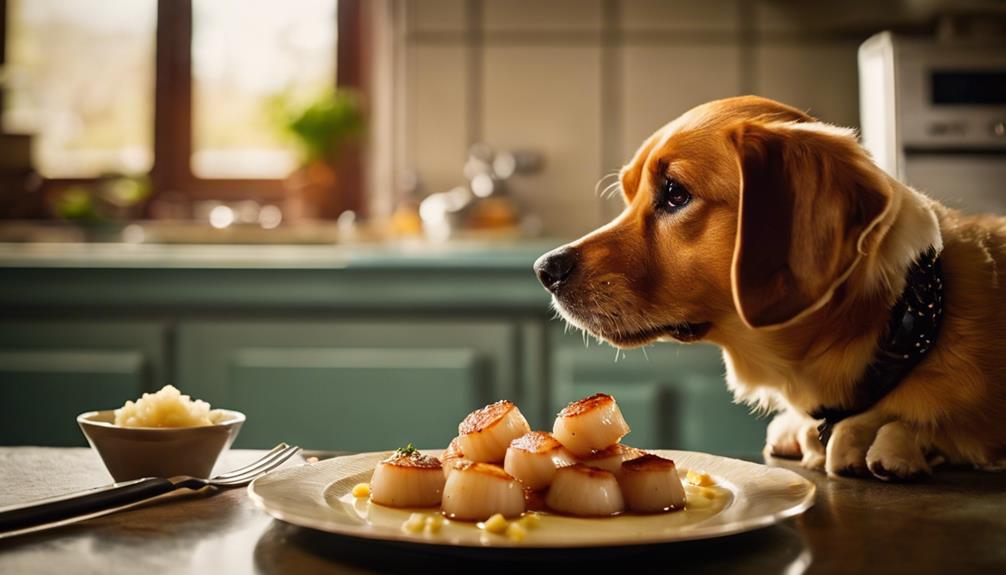
To ensure your dog enjoys scallops safely, consider their size, activity level, and health. It’s crucial to manage portions to keep their diet balanced and avoid any digestive issues. Here’s how to do it:
For dogs of different weights, a good rule of thumb is offering 1 to 2 small scallop pieces for every 20 pounds they weigh. Scallops are a treat, so they should only be a small part of your dog’s diet to prevent any digestive problems and ensure they’re getting a variety of nutrients.
It’s also important to tailor the amount of scallops based on your pet’s unique characteristics. If your dog is particularly active or has specific health concerns, you might need to adjust how many scallops they get. Always talking to a veterinarian is a wise move before adding anything new to your dog’s diet, to make sure it’s a healthy choice for them.
Recognizing Allergic Reactions

Knowing how to spot allergic reactions in dogs after they eat scallops is key for their health. You should look out for signs like scratching or stomach issues.
If your dog starts having trouble breathing, it’s critical to act fast. For dogs with a shellfish allergy, understanding how to manage their condition over time is also important.
This helps dog owners take good care of their pets, ensuring they stay healthy.
Identifying Allergic Symptoms
Knowing how to spot allergic reactions in dogs is crucial, especially after they eat something like scallops. Quick recognition and action can greatly improve your dog’s health. For dog owners, here’s what you need to keep in mind:
- Understand common allergens such as scallops and create ways to keep your dog away from them. This is key for preventing allergic reactions.
- If your dog shows signs of an allergy, like itching or stomach issues, adjusting their diet may help. This step can relieve their discomfort and support their overall well-being.
- It’s important to consult a vet if you think your dog has an allergy. They can confirm your suspicions and discuss different ways to treat the issue.
- Keep an eye out for serious signs of an allergy, including swelling of the face or trouble breathing. These symptoms require quick action and a trip to the vet.
Immediate Reaction Steps
When your dog eats scallops, it’s crucial to watch them closely for any signs of an allergic reaction, such as itching, swelling, or stomach issues. If you notice symptoms like vomiting, diarrhea, or if they’re having trouble breathing, get in touch with your vet right away, as these could be signs that your dog needs urgent care. Knowing if your dog has food sensitivities, possibly through allergy testing, can help you avoid these situations in the future.
Treatment varies depending on how severe the allergic reaction is, which makes talking to your vet so important. Keeping track of any reactions your dog has can help you and your vet come up with a plan to prevent future issues. Acting quickly if your dog shows signs of distress after eating scallops is key to keeping them healthy, making regular vet visits and a customized care plan critical.
Long-Term Management Tips
Ensuring your dog’s health after they’ve had an allergic reaction to scallops involves careful monitoring and making changes to their diet. Here’s how you can manage your dog’s allergy effectively:
Visit a vet to get a professional opinion on the allergy and talk about other food options instead of scallops. Keep a log of any allergic reactions to pinpoint what’s causing them and to see how well the new diet works. Replace scallops with different protein sources that your dog can eat safely, ensuring these alternatives provide all the necessary nutrients without triggering an allergic response.
Always watch your dog for any signs of allergies and tweak their diet as needed to keep them healthy and happy.
These steps are key to dealing with your dog’s allergy to scallops in a way that keeps them feeling their best.
Alternatives to Scallops
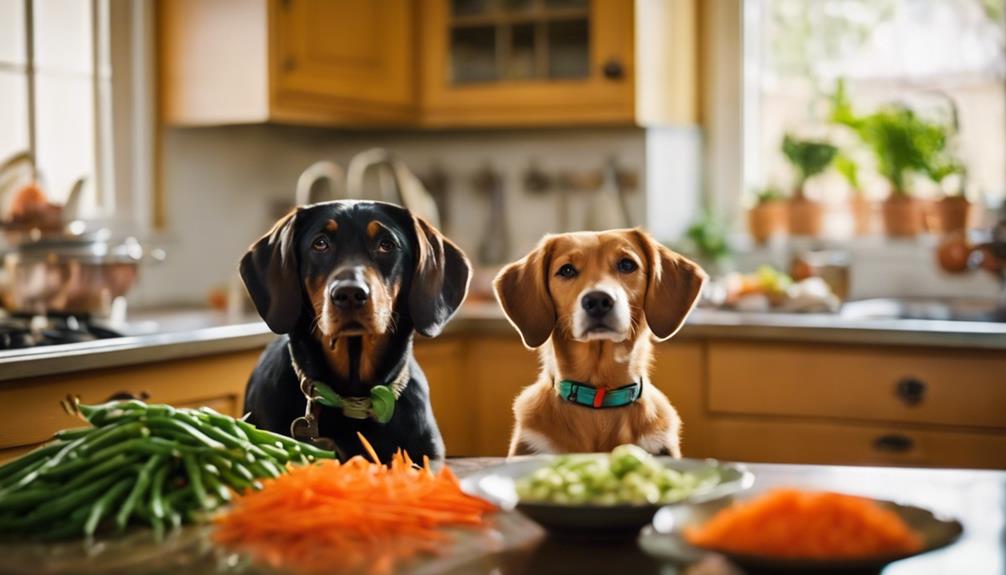
Scallops might not be the best choice for every dog, but there’s a wide range of safe and nutritious alternatives that pet owners can consider. From seafood like cooked shrimp or fish to lean meats and vegetables, there are plenty of options. Seafood alternatives, when chosen with care and cooked properly, such as shrimp or fish, can be a great source of essential nutrients without the risks that scallops might pose.
Protein is vital for a dog’s health, and lean meats like cooked chicken or turkey are packed with these important nutrients and are easy for dogs to digest. For those looking to add some healthy treats to their dog’s diet, vegetables like cooked carrots or green beans, and fruits such as apples or berries, are excellent sources of vitamins and minerals.
Plain, cooked rice or pasta can also be a good, simple alternative, helping to ensure a balanced diet for your dog. These options not only keep your dog healthy but can also add some variety to their meals, making feeding time something both you and your dog can look forward to.
Risks of Raw Scallops

Offering raw scallops to dogs can lead to serious health issues due to the potential for toxins and bacterial contamination. These filter feeders can accumulate harmful substances, making them risky treats for pets.
Toxins in the orange part of scallops are particularly dangerous for dogs. Scallops, being filter feeders, might also carry contaminants from their surroundings. Plus, scallops sourced from polluted waters carry even greater health risks. Eating raw scallops can expose dogs to foodborne illnesses.
To keep dogs safe, it’s crucial to source scallops carefully and cook them properly before feeding.
Seasoning and Dogs Health
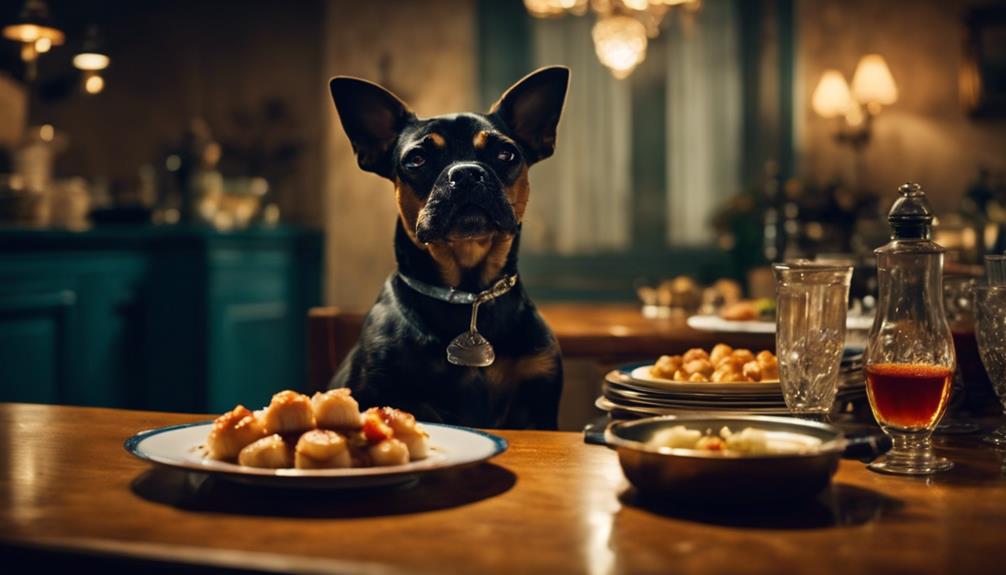
When considering what to feed our pets, especially dogs, we often overlook the impact of seasonings. Ingredients like garlic and onion are not just bad for their stomachs but can be toxic. Dogs have delicate digestive systems, and what’s okay for us can harm them. For instance, too much salt can cause serious health issues like sodium ion poisoning.
It’s crucial to stick to plain, unseasoned foods when feeding our furry companions. Before you think about adding any sort of seasoning to your dog’s meal, talking to a vet is a wise move. This ensures you’re keeping your pet’s health a top priority and avoids any unnecessary complications that could arise from their dietary sensitivity.
Incorporating Scallops in Diets
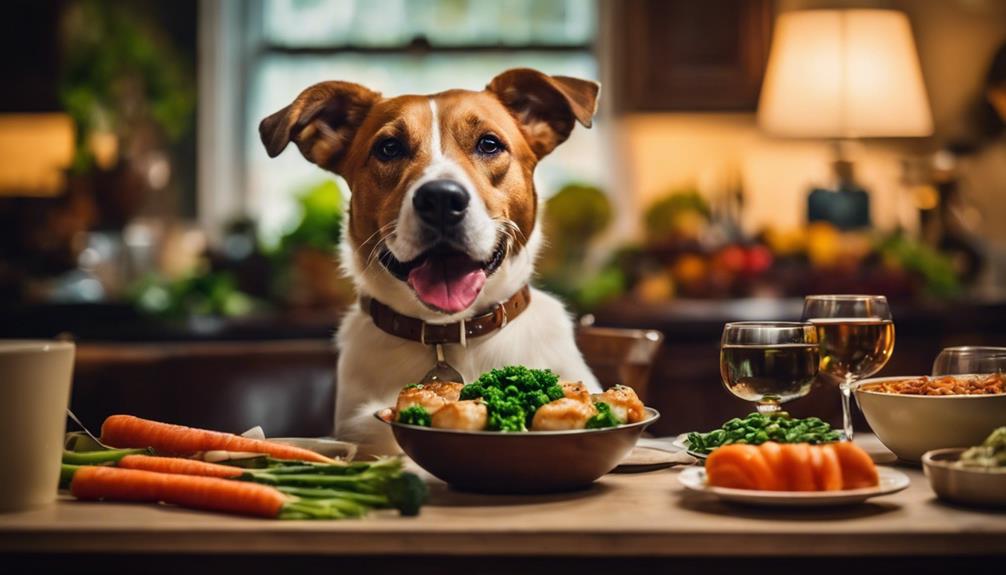
Scallops can be a nutritious addition to your dog’s meals, offering a great source of protein and vital nutrients. However, it’s crucial to introduce them to your pet cautiously and in moderation. Here’s how you can do it right:
- Nutritional Benefits: Scallops are packed with protein and important nutrients that can support your dog’s health. Including scallops in their diet can be beneficial, but it’s essential to know how to do it correctly.
- Cooking Scallops: It’s important to cook scallops well before feeding them to your dog. Avoid adding any seasonings that could be harmful, such as garlic or onions. Proper preparation ensures that scallops are safe and healthy for your pet.
- Taste Preferences: Pay attention to how your dog reacts to scallops. This will help you understand their taste preferences and ensure they enjoy this new addition to their diet.
- Diet Considerations: If your dog has any dietary restrictions, it’s necessary to take these into account when introducing scallops. Adjusting the introduction of scallops can help prevent any negative reactions.
Consulting Vets on Scallops
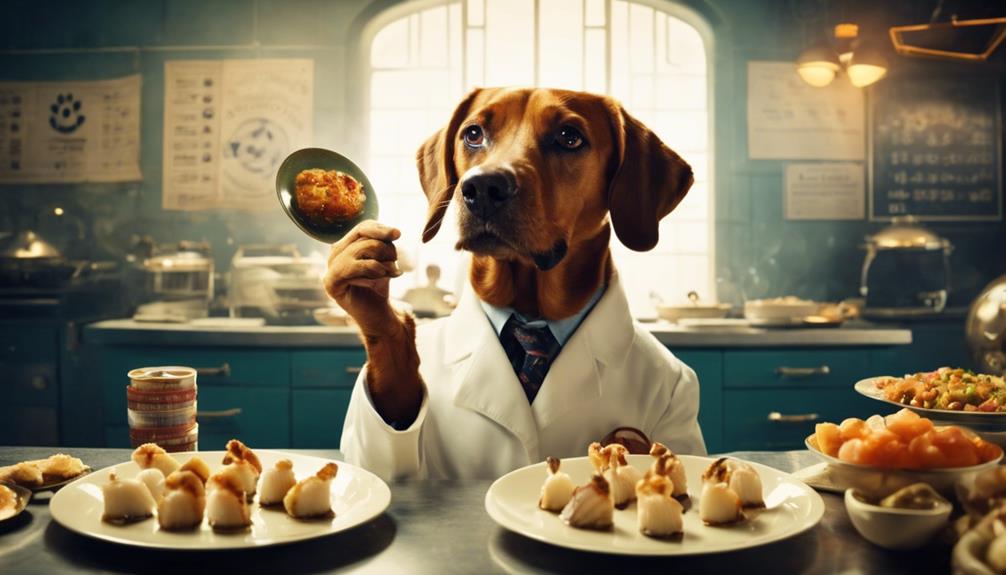
Before adding scallops to your dog’s diet, it’s wise to talk to a vet. This step ensures the food matches your pet’s health and diet needs. Vets offer tailored guidance, drawing on their knowledge of what’s best for dogs to eat. They help identify if your dog might react badly to scallops through allergy tests. This way, your dog stays safe and healthy.
Vets also help with portion control to avoid feeding your dog too much. They’ll suggest how to cook scallops in a way that keeps them healthy for your pet. This careful planning means scallops can be a good part of your dog’s diet.
Frequently Asked Questions
What Seafood Is Safe for Dogs?
- Cook plain, cooked salmon; avoid raw for safety.
- Check for fish allergies before feeding.
- Consult a vet for personalized dietary advice.
Are Cooked Scallops Safe?
- Cooked scallops are safe for dogs if cooked right.
- Watch for allergies and control portions.
- Proper preparation ensures their safety in a dog’s diet.
Can You Eat Scallops Raw?
- Scallops can be safely eaten raw with careful selection.
- Raw consumption may expose you to bacteria and toxins.
- Proper handling preserves their delicate flavor.
Are Scallops Healthy?
- Scallops are rich in protein and omega-3s.
- Beware of allergic reactions when eating scallops.
- Correct cooking ensures safety and health benefits.

